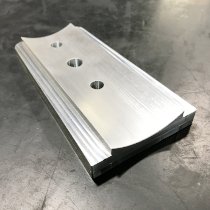Metal machining REPAIRS
Get a Quote For Your Project
High Precision Metal Machining and Steel Fabrication Shop
Our Expert Machinist Can Easily Fabricate Metal Machined Parts or Repair Existing Machined Parts
Machine or Fabricate Metal Parts and Tools
Bay Tec3D provides in-house metal machining services which is an economical way to make machined parts requiring a high degree of precision and accuracy. We can provide precision custom metal machining services, manufacture turned parts with difficult metals, tough tolerances and challenging geometries.
Metal Machining and steel fabrication are an economical way to replace worn out seal parts or hard to replace parts not available on the market any longer. We can offer lower prices than most other place because we have our in-house machinist with years of experience.
Metal Machining Operations Using Lathe, Drilling and Milling Equipment
Machining is a broad term used to describe the process, wherein a piece of raw material is cut into a desired final shape and size by a controlled material-removal process. It includes several general processes which fall into several categories; Turning, Drilling and Milling.
- Turning operations rotate the workpiece as the primary method of moving metal against the cutting tool.
- Milling operations are operations in which the cutting tool rotates to bring cutting edges to bear against the workpiece.
- Drilling operations refers to holes produced or refined by bringing a rotating cutter with cutting edges at the lower extremity into contact with the workpiece.
Processes involving controlled material removal are collectively known as subtractive manufacturing.
- Boring : Produces precise circular internal profiles.
- Chamfering : Transitional edge between two faces of an object. A form of bevel, created at 45° angle to two adjoining right-angled faces.
- Counterboring : A cylindrical flat-bottomed hole that enlarges another coaxial hole. A counterbore hole is typically used when a fastener, such as a socket head cap screw, is required to sit flush with or below the level of a workpiece’s surface.
- Countersinking : Whereas a counterbore is a flat-bottomed enlargement of a smaller coaxial hole, a countersink is a conical enlargement of such. A outface often takes the form of a very shallow counterbore.
- Drilling : Using a drill bit to cut a hole of circular cross-section in solid materials.
- Facing : Cutting a face, which is a planar surface, onto the workpiece.
- Filing : Material removal process in manufacturing. Similar to both sawing and grinding in effect, it is functionally versatile, but used mostly for finishing operations, namely in deburring operations.
- Forming : Fashioning metal parts and objects through mechanical deformation; the workpiece is reshaped without adding or removing material, and its mass remains unchanged.
- Grinding : An abrasive machining process that uses a grinding wheel as the cutting tool.
- Grooving: A non-rotary tool bit, describes a helix toolpath by moving more or less linearly while the workpiece rotates.
- Knurling : A pattern of straight, angled or crossed lines is rolled into the material.
- Milling : Machining process using rotary cutters to remove material from a workpiece by advancing the cutter into the workpiece at a certain direction.
- Reaming : The process of enlarging the hole is called reaming. Whether precision reaming for high level accuracy or basic reaming for enlargement and/or removing burrs.
- Parting : A blade-like cutting tool plunged directly into the workpiece to cut off the workpiece at a specific length.
- Polishing : A blade-like cutting tool plunged directly into the workpiece to cut off the workpiece at a specific length.
- Taper Turning : A non-rotary tool bit, describes a helix toolpath by moving more or less linearly while the workpiece rotates.
- Tapping : Taps and dies are tools used to create screw threads. A tap is used to form the female portion of the mating pair, (e.g. a nut).
- Threading (external, internal) : A die is used to cut or form the male portion of the mating pair (e.g. a bolt), referred to as threading.
- Thread Milling : Produces threads with the circular ramping movement of a rotating tool. The lateral movement of the tool in one revolution creates the thread pitch.











